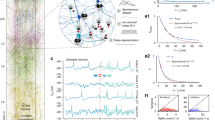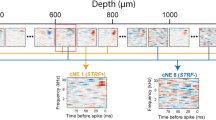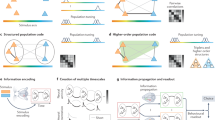Abstract
The cerebral cortex processes information primarily through changes in the spike rates of neurons within local ensembles. To evaluate how reliably the average spike rate of a group of cortical neurons can represent a time-varying signal, we simulated an ensemble with realistic spike discharge behavior. We found that weak interneuronal correlation, or synchrony, allows the variability in spike rates of individual neurons to compromise the ensemble representation of time-varying signals. Brief cycles of sinusoidal modulation at frequencies above 115 Hz could not be represented by an ensemble of hundreds of neurons whose interneuronal correlation mimics that of the visual cortex. The spike variability and correlation assumed in our simulations are likely to apply to many areas of cortex and therefore may constrain the fidelity of neural computations underlying higher brain function.
This is a preview of subscription content, access via your institution
Access options
Subscribe to this journal
Receive 12 print issues and online access
$209.00 per year
only $17.42 per issue
Buy this article
- Purchase on Springer Link
- Instant access to full article PDF
Prices may be subject to local taxes which are calculated during checkout






Similar content being viewed by others
References
Softky, W. R. & Koch, C. The highly irregular firing of cortical cells is inconsistent with temporal integration of random EPSPs. J. Neurosci. 13, 334–350 (1993).
Shadlen, M. N. & Newsome, W. T. Noise, neural codes and cortical organization. Curr. Opin. Neurobiol. 4, 569–579 (1994).
Shadlen, M. N. & Newsome, W. T. The variable discharge of cortical neurons: implications for connectivity, computation and information coding. J. Neurosci. 18, 3870–3896 (1998).
Braitenberg, V. & Schuz, A. Anatomy of the Cortex: Statistics and Geometry (Springer, Berlin, 1991).
Albright, T. D., Jessell, T. M., Kandel, E. R. & Posner, M. I. Neural science: a century of progress and the mysteries that remain. Neuron 25 Suppl, S1–S55 (2000).
Shadlen, M. N. & Movshon, J. A. Synchrony unbound: a critical evaluation of the temporal binding hypothesis. Neuron 24, 67–77 (1999).
Singer, W. Neuronal synchrony: a versatile code for the definition of relations? Neuron 24, 49–65 (1999).
Johnson, K. O. Sensory discrimination: neural processes preceding discrimination decision. J. Neurophysiol. 43, 1793–1815 (1980).
Zohary, E., Shadlen, M. N. & Newsome, W. T. Correlated neuronal discharge rate and its implications for psychophysical performance [published erratum appears in Nature 1994 Sep 22;371(6495):358]. Nature 370, 140–143 (1994).
Bair, W., Zohary, E. & Newsome, W. T. Correlated firing in Macaque visual area MT: time scales and relationship to behavior. J. Neurosci. 21, 1676–1697 (2001).
Fetz, E., Toyama, K. & Smith, W. in Cerebral Cortex (eds. Peters, A. & Jones, E. G.) 1–47 (Plenum, New York, 1991).
Gawne, T. J. & Richmond, B. J. How independent are the messages carried by adjacent inferior temporal cortical neurons? J. Neurosci. 13, 2758–2771 (1993).
Das, A. & Gilbert, C. D. Receptive field expansion in adult visual cortex is linked to dynamic changes in strength of cortical connections. J. Neurophysiol. 74, 779–792 (1995).
Lee, D., Port, N. L., Kruse, W. & Georgopoulos, A. P. Variability and correlated noise in the discharge of neurons in motor and parietal areas of the primate cortex. J. Neurosci. 18, 1161–1170 (1998).
Salinas, E., Hernandez, A., Zainos, A. & Romo, R. Periodicity and firing rate as candidate neural codes for the frequency of vibrotactile stimuli. J. Neurosci. 20, 5503–5515 (2000).
Gerstein, G. & Mandelbrot, B. Random walk models for the spike activity of a single neuron. Biophys. J. 4, 41–68 (1964).
Ricciardi, L. & Sacerdote, L. The Ornstein-Uhlenbeck process as a model for neuronal activity. Biol. Cybern. 35, 1–9 (1979).
van Vreeswijk, C. & Sompolinsky, H. Chaos in neuronal networks with balanced excitatory and inhibitory activity. Science 274, 1724–1726 (1996).
Shinomoto, S., Sakai, Y. & Funahashi, S. The Ornstein-Uhlenbeck process does not reproduce spiking statistics of neurons in prefrontal cortex. Neural Comput. 11, 935–951 (1999).
Salinas, E. & Sejnowski, T. J. Impact of correlated synaptic input on output firing rate and variability in simple neuronal models. J. Neurosci. 20, 6193–6209 (2000).
Werner, G. & Mountcastle, V. B. The variability of central neural activity in a sensory system, and its implications for the central reflection of sensory events. J. Neurophysiol. 26, 958–977 (1963).
Gawne, T. J., Kjaer, T. W., Hertz, J. A. & Richmond, B. J. Adjacent visual cortical complex cells share about 20% of their stimulus-related information. Cerebral Cortex 6, 482–489 (1996).
van Kan, P. L. E., Scobey, R. P. & Gabor, A. J. Response covariance in cat visual cortex. Exp. Brain Res. 60, 559–563 (1985).
Lampl, I., Reichova, I. & Ferster, D. Synchronous membrane potential fluctuations in neurons of the cat visual cortex. Neuron 22, 361–374 (1999).
Green, D. M. & Swets, J. A. Signal Detection Theory and Psychophysics (Wiley, New York, 1966).
Vaadia, E. et al. Dynamics of neuronal interactions in monkey cortex in relation to behavioural events. Nature 373, 515–518 (1995).
Brody, C. D. Disambiguating different covariation types. Neural Comput. 11, 1527–1535 (1999).
Brody, C. D. Correlations without synchrony. Neural Comput. 11, 1537–1551 (1999).
Oram, M. W., Wiener, M. C., Lestienne, R. & Richmond, B. J. Stochastic nature of precisely timed spike patterns in visual system neuronal responses. J. Neurophysiol. 81, 3021–3033 (1999).
Ts'o, D. Y., Gilbert, C. D. & Wiesel, T. N. Relationships between horizontal interactions and functional architecture in cat striate cortex as revealed by cross-correlation analysis. J. Neurosci. 6, 1160–1170 (1986).
Murthy, V. N. & Fetz, E. E. Effects of input synchrony on the firing rate of a three-conductance cortical neuron model. Neural Comput. 6, 1111–1126 (1994).
Stevens, C. F. & Zador, A. M. Input synchrony and the irregular firing of cortical neurons. Nat. Neurosci. 1, 210–218 (1998).
Usrey, W. M., Alonso, J. M. & Reid, R. C. Synaptic interactions between thalamic inputs to simple cells in cat visual cortex. J. Neurosci. 20, 5461–5467 (2000).
Engel, A. K., Roelfsema, P. R., Fries, P., Brecht, M. & Singer, W. Role of the temporal domain for response selection and perceptual binding. Cerebral Cortex 7, 571–582 (1997).
Riehle, A., Grün, S., Diesmann, M. & Aertsen, A. Spike synchronization and rate modulation differentially involved in motor cortical function. Science 278, 1950–1954 (1997).
Di Lorenzo, P. M. & Lemon, C. H. The neural code for taste in the nucleus of the solitary tract of the rat: effects of adaptation. Brain Res. 852, 383–397 (2000).
Lumer, E. D., Friston, K. J. & Rees, G. Neural correlates of perceptual rivalry in the human brain. Science 280, 1930–1934 (1998).
Mountcastle, V. B., Talbot, W. H., Sakata, H. & Hyvärinen, J. Cortical neuronal mechanisms in flutter-vibration studied in unanesthetized monkeys. Neuronal periodicity and frequency discrimination. J. Neurophysiol. 32, 452–484 (1969).
Harris, C. M. & Wolpert, D. M. Signal-dependent noise determines motor planning. Nature 394, 780–784 (1998).
Bair, W. & Koch, C. Temporal precision of spike trains in extrastriate cortex. Neural Comput. 8, 1185–1202 (1996).
Teich, M. C., Heneghan, C., Lowen, S. B., Ozaki, T. & Kaplan, E. Fractal character of the neural spike train in the visual system of the cat. J. Opt. Soc. Am. A 14, 529–546 (1997).
Oertel, D. The role of timing in the brain stem auditory nuclei of vertebrates. Annu. Rev. Physiol. 61, 497–519 (1999).
Abbott, L. F. & Dayan, P. The effect of correlated variability on the accuracy of a population code. Neural Comput. 11, 91–101 (1998).
Britten, K. H., Shadlen, M. N., Newsome, W. T. & Movshon, J. A. The analysis of visual motion: a comparison of neuronal and psychophysical performance. J. Neurosci. 12, 4745–4765 (1992).
Salzman, C. D., Murasugi, C. M., Britten, K. H. & Newsome, W. T. Microstimulation in visual area MT: effects on direction discrimination performance. J. Neurosci. 12, 2331–2355 (1992).
Hernandez, A., Zainos, A. & Romo, R. Neuronal correlates of sensory discrimination in the somatosensory cortex. Proc. Natl. Acad. Sci. USA 97, 6191–6196 (2000).
Romo, R., Hernandez, A., Zainos, A., Brody, C. D. & Lemus, L. Sensing without touching: psychophysical performance based on cortical microstimulation. Neuron 26, 273–278 (2000).
Destexhe, A. & Pare, D. Impact of network activity on the integrative properties of neocortical pyramidal neurons in vivo. J. Neurophysiol. 81, 1531–1547 (1999).
Press, W. H., Teukolsky, S. A., Vetterling, W. T. & Flannery, B. P. Numerical Recipes in C: The Art of Scientific Computing (Cambridge Univ. Press, 1992).
Acknowledgements
Supported by HHMI, NIH grants RR00166 and EY11378 and the McKnight Foundation. M.E.M. was supported by an NIH training grant (GM07108), a Poncin grant and an ARCS fellowship. We thank C. Brody, J. Ditterich, J. Gold, M. Leon and M. McKinley for comments and discussion.
Author information
Authors and Affiliations
Corresponding author
Ethics declarations
Competing interests
The authors declare no competing financial interests.
Supplementary information
Rights and permissions
About this article
Cite this article
Mazurek, M., Shadlen, M. Limits to the temporal fidelity of cortical spike rate signals. Nat Neurosci 5, 463–471 (2002). https://doi.org/10.1038/nn836
Received:
Accepted:
Published:
Issue Date:
DOI: https://doi.org/10.1038/nn836
This article is cited by
-
The structures and functions of correlations in neural population codes
Nature Reviews Neuroscience (2022)
-
Analytic Investigation for Synchronous Firing Patterns Propagation in Spiking Neural Networks
Neural Processing Letters (2022)
-
Correlations enhance the behavioral readout of neural population activity in association cortex
Nature Neuroscience (2021)
-
Information propagation in recurrent neuronal populations with mixed excitatory–inhibitory synaptic connections
Nonlinear Dynamics (2021)
-
Propagation of temporal and rate signals in cultured multilayer networks
Nature Communications (2019)



